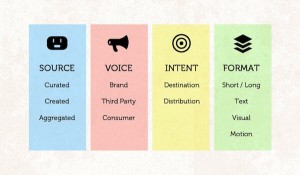2.7 Storytelling and the Information Strategy
The way information is crafted into the final media message depends on two key factors:
- how the message is being delivered (a story in a newspaper versus on a mobile device, a TV brand ad or one in an interactive magazine)
- the audience for whom the message is intended
The storytelling techniques you use must take into account the media format in which the information is delivered and the audience expectations for the message.

While this course does not delve into the actual construction of the messages themselves – you will get those skills in your reporting or strategic writing classes – it is worthwhile to acknowledge some of the considerations that message creators must keep in mind – and the information requirements there might be for different storytelling conventions.
Goals of Storytelling
Storytelling can serve different kinds of goals. Determining the intention or purpose of the story or message is an important first step in crafting the message. As you have learned, messages can inform or enlighten people about current events or issues or about the availability of products or services. They can provide background and context to a discussion of ideas. Stories can be written to persuade people to make certain purchases or hold certain views. News, advertising and public relations messages perform some or all of these functions while employing different storytelling techniques and formats to communicate with audiences in the most effective way.
There are a number of different storytelling decisions to make as a producer of media content. Regardless of which type of media you are working within, it is important that you, the communicator, are aware of the fundamental storytelling devices you might want to use to tell your story in a way that is direct, efficient, and appropriate for the story’s objective. Therefore, you will want to have a full and accessible set of tools that you are ready to employ for any kind of message, depending on the type of media you are creating, your chosen channel of communication, as well as the specific style, tone, and needs of your story subject.
Characteristics of Good Storytelling
Usually the word “story” implies something fictional. But in the case of media messages “story” refers to fact-based information about products, or events, or the actions taken by a company. The distinction between fiction and non-fiction stories is an absolutely critical one for you to grasp. It affects every decision that you make about the selection and evaluation of information for messages.
Good storytelling consists of knowing your audience. Is the audience going to be reading the story, hearing it, experiencing it in a non-linear fashion online? What kind of background information does the audience for the story already have about the topic?
Good storytelling also begins with a foundation in the subject matter. The storyteller must have a firm grasp of the subject matter in order to effectively communicate the story to someone else.
Good storytelling demands that the storyteller have command of the mechanics of writing.
Good storytelling understands how different media elements play into the effective telling of the story.
Good storytelling demonstrates ethical standards for accuracy, truth, verifiability, sufficient evidence and information reliability. Non-fiction stories, especially, require solid grounding in factual information that can withstand scrutiny by the most skeptical audience members.
Storytellers must deliver within the parameters and requirements of the story assignment.
They must:
- meet the deadline
- follow directions on the expected length and focus for the story
- meet the expectation for clean, distribution-ready copy
- use proper grammar, word choice and style
- apply the appropriate story characteristics for the channel of message delivery
The information strategy skills you will learn in this course will provide you with the tools you need to meet these storytelling requirements. Moving confidently through the information strategy process will help you identify your audience, locate the relevant content for your message, ensure the accuracy of your information and provide the details that will make your message stand out.

